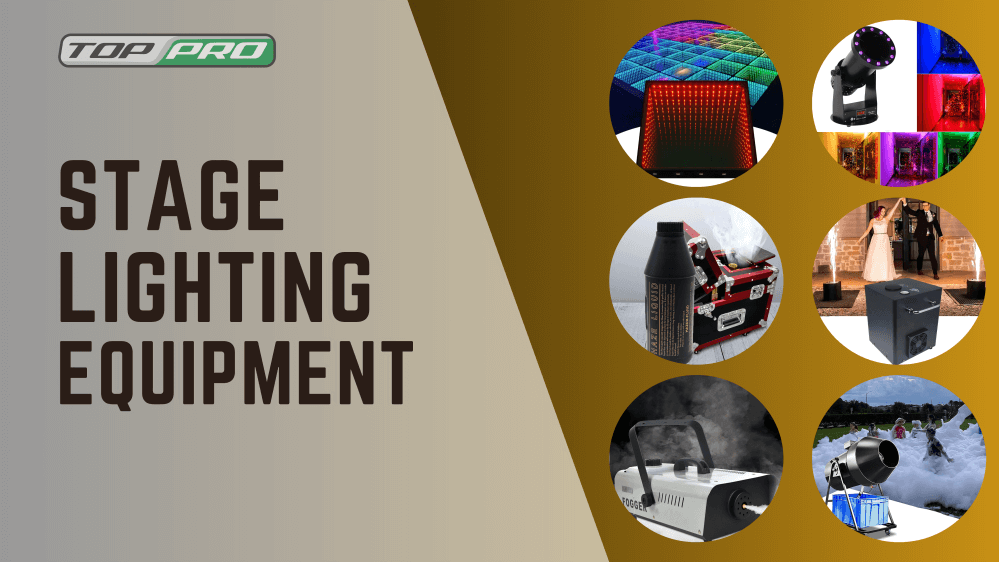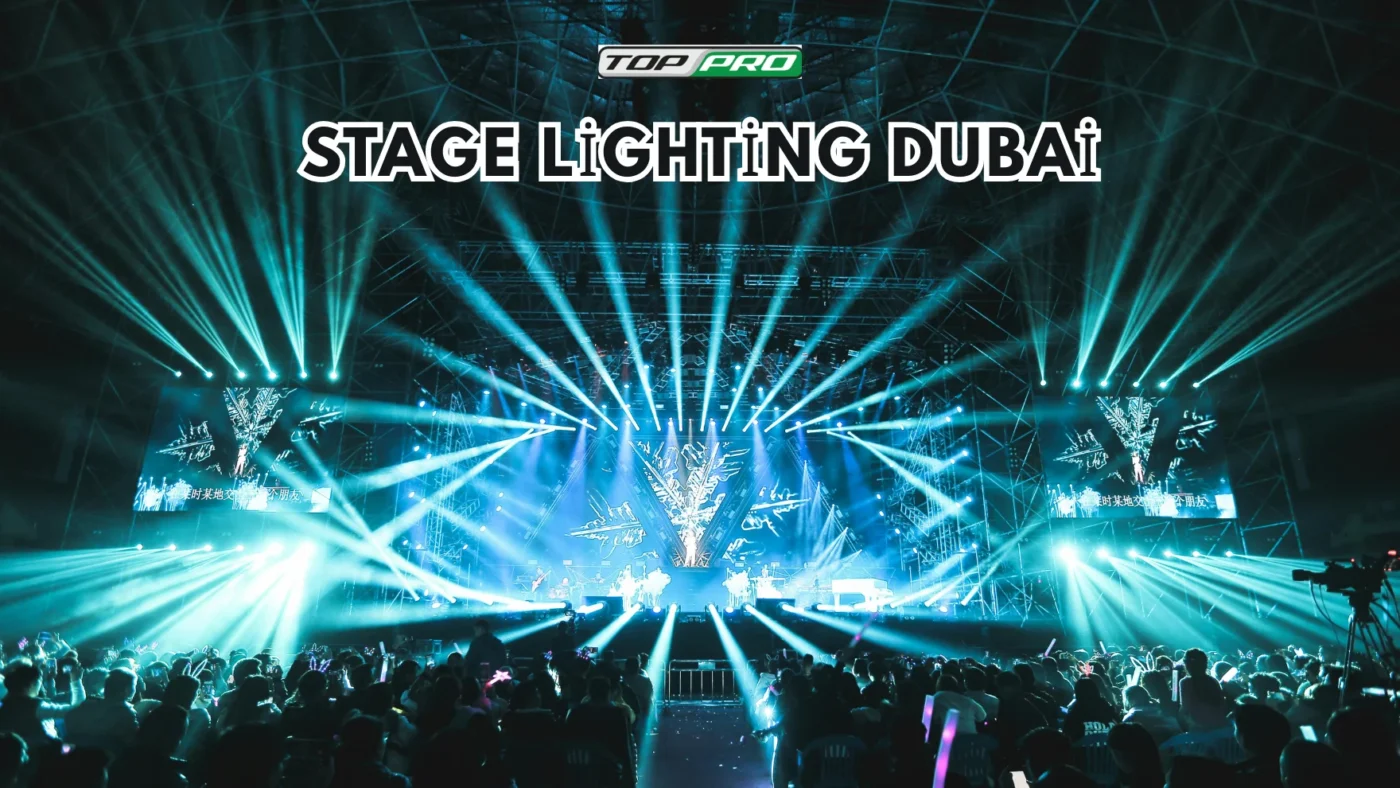A Beginner’s Guide to Stage Lighting Equipment

Stage lighting is essential to any live performance, from theatre productions to concerts and events. Proper lighting illuminates the performers, sets the mood, directs the audience’s attention, and enhances the overall visual experience. This guide to Stage Lighting Equipment is a comprehensive introduction to the essential equipment and concepts in stage lighting, making it an invaluable resource for budding theatre technicians, musicians, and event planners.
Fundamentals of the Guide to Stage Lighting Equipment
The primary function is to ensure that performers are visible to the audience. Proper illumination helps convey facial expressions, movements, and other critical aspects of the performance.
Lighting can create a range of atmospheres, from a warm, inviting glow to a cold, eerie effect. Different colors, intensities, and angles can evoke specific emotions and set the tone for each scene.
Lighting directs the audience’s attention to particular areas of the stage, ensuring that essential actions and elements are highlighted while others remain subdued.
Lighting Positions
Understanding the placement of lights is fundamental to adequate stage lighting. Key positions include:
Where to Place a Front Light? Positioned in front of the performers, these lights provide visibility and highlight facial expressions. They are essential for clear, direct illumination.
Backlight: Placed behind the performers, backlighting creates depth and separation from the background, enhancing the stage’s three-dimensional appearance.
Sidelight: Positioned at the sides of the stage, sidelights emphasize movements and contours, adding dynamism and highlighting the performers’ form.
Each lighting position impacts the visual experience differently, and a balanced combination helps create a cohesive and engaging stage environment.
Essential Lighting Fixtures
PAR Cans
PAR (Parabolic Aluminized Reflector) cans are among the most common and versatile lighting fixtures. Known as the workhorses of stage lighting, PAR cans produce focused beams, making them ideal for highlighting specific areas or performers on stage. They are inexpensive and easy to use, making them a staple in many lighting setups.
Fresnels
Fresnel fixtures are named after the French engineer Augustin-Jean Fresnel, who invented the Fresnel lens. These lights are renowned for their adjustable beam angles, which enable both broad washes and tight spotlights. Fresnels provide a soft-edged light ideal for creating smooth, even washes of light across the stage or focusing on specific areas without harsh edges.
Moving Heads
Moving head fixtures are intelligent lights that pan, tilt, and change color, creating dynamic and versatile lighting effects. These fixtures are controlled via lighting consoles, allowing intricate programming and synchronization with the performance. Moving heads are a popular choice in concerts and large-scale events where elaborate light shows are desired.
LED Panels
LED panels are modern, energy-efficient fixtures that offer a broad spectrum of colors and smooth dimming capabilities. Compared to traditional lighting fixtures, they consume less power and generate less heat, making them an environmentally friendly option. LED panels are versatile and can be used for general lighting and special effects.
Understanding Lighting Control
Lighting Control Systems
Lighting control systems are essential for programming and executing lighting cues, ensuring a polished and professional performance. These systems range from simple analog controls to sophisticated digital consoles.
Analog Systems: These are basic systems where each light is controlled individually. While they are straightforward to use, they offer limited flexibility and precision.
Digital Systems: Digital consoles offer advanced control, enabling the programming of intricate lighting sequences and effects. They can manage multiple fixtures simultaneously, creating synchronized light shows that enhance the performance.
Dimmers
Dimmers play a crucial role in controlling the intensity of lights, allowing for gradual transitions and creating dramatic effects. By adjusting the voltage supplied to the light fixtures, dimmers can make subtle changes in brightness, enhancing the mood and atmosphere of the performance.
Choosing the Right Equipment for Your Needs
Selecting the appropriate stage lighting equipment depends on several factors:
Type of Event
Consider the nature of the event:
Plays and Theatrical Performances: Require precise, controlled lighting to effectively highlight actors and facilitate seamless set changes. Fresnels and LED panels are often used for their versatility.
Concerts: Demand dynamic and colorful lighting effects. Moving heads and PAR cans are popular choices for their ability to create vibrant, shifting light shows.
Presentations and Corporate Events typically require straightforward, professional lighting to illuminate speakers and presenters. LED panels and Fresnels are suitable for creating even, flattering light.
Venue Size and Layout
The size and layout of the venue significantly impact lighting requirements:
Throw Distance: The distance between the light fixture and the stage affects the type of fixture needed. Larger venues require lights with greater throw distances to ensure adequate coverage.
Beam Angle: The beam angle determines the width or narrowness of the light spread. Wider beam angles are suitable for general washes, while narrow angles are ideal for focused spotlights.
Color Temperature
Color temperature affects the mood and ambiance of the performance:
Warm White: Creates a cozy, intimate atmosphere, often used in theatrical scenes.
Cool White: Produces a crisp, clean light for contemporary and energetic performances.
Neutral White: A balanced, natural light is ideal for presentations and events requiring clear visibility.
Beyond the Basics: Special Effects Lighting (Optional)
For those looking to delve deeper into stage lighting, special effects lighting can add an extra layer of excitement and drama:
Strobes
Strobe lights produce quick, flashing bursts of light, creating a sense of motion and intensity. They are commonly used in concerts and dance performances for dramatic, high-energy effects.
Lasers
Laser lights generate precise light beams that can create intricate patterns and designs. They are often used in concerts and large-scale events to produce visually stunning effects.
Fog machines emit a cloud of mist that interacts with the lighting, enhancing beams and creating a mystical or atmospheric effect. They are used sparingly to add depth and texture to the lighting design.
FAQ
1. What is the most basic lighting setup for a small stage?
A simple setup usually includes a few PAR cans for general illumination, a couple of Fresnels for softer washes, and a basic lighting controller or dimmer to manage brightness and simple transitions.
2. How do I choose between LED panels and traditional lights like PAR cans?
LED panels are more energy-efficient, offer a wider range of colors, and generate less heat, making them ideal for long performances. PAR cans, however, are great for intense, focused beams and are often more budget-friendly for basic setups.
3. Do I need a lighting control system for small events?
Even for small events, a basic lighting controller can make a huge difference. It helps you smoothly adjust light intensity, switch scenes, and create simple effects that can make your event feel more polished and professional.
4. How important is color temperature in stage lighting?
Color temperature sets the mood of a performance. Warm white light creates a cozy, intimate feel, while cool white light feels more modern and energetic. Choosing the right color temperature helps create the atmosphere you want.
Stage lighting is an art form that combines technical skills with creative vision. You can create compelling and visually stunning performances by understanding the fundamentals, exploring different fixtures, and learning about lighting control. Whether lighting a small community theatre production or a large concert, the right equipment and techniques can elevate your event and captivate your audience. With this guide as your starting point, you’re well on your way to mastering the exciting world of stage lighting.








